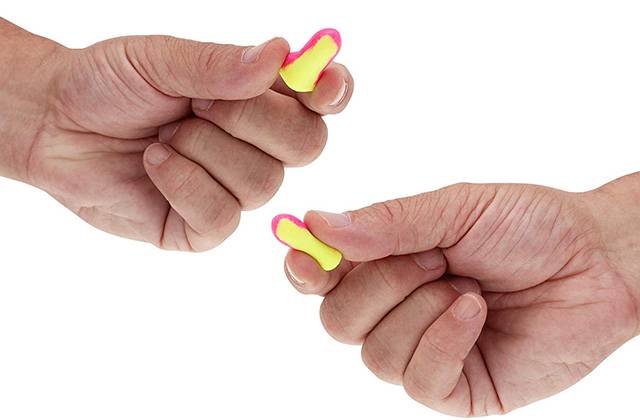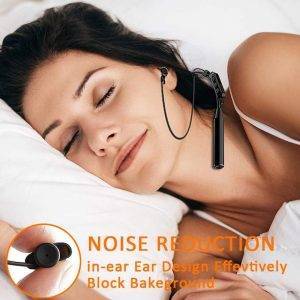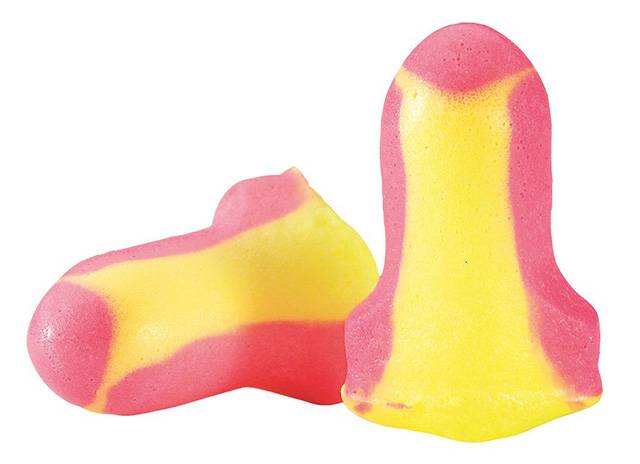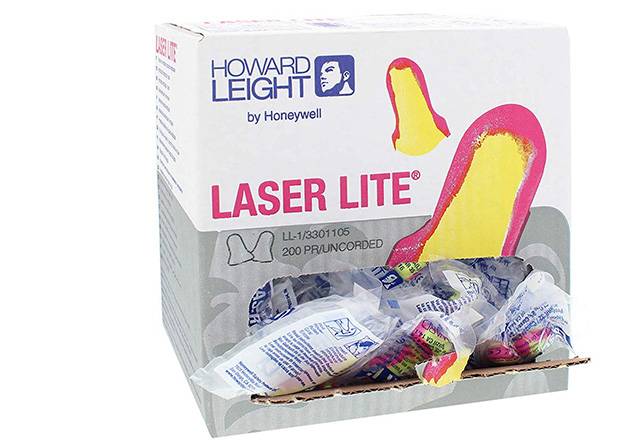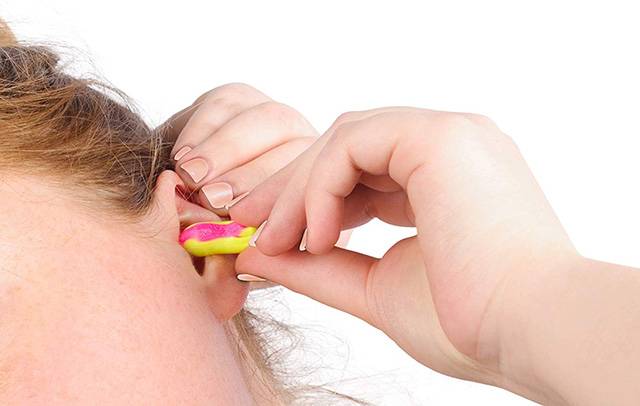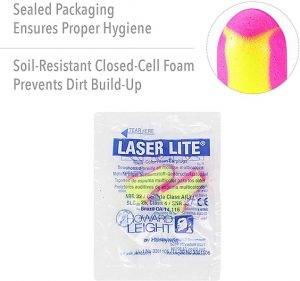
While there are endless options available in the market, our topic of discussion today is the very popular Laser Lite® foam earplugs by Howard Leight. Known for their ease-of-use and comfortable wear, these foam earplugs are designed to provide maximum noise cancellation properties, even those suitable to loud work environments. They can cater to anything from sleep and air travel to operating heavy machinery and industry use.
But before we take a good, long look at these earplugs, here is some general info on foam earplugs.
What are Foam Earplugs?
Foam earplugs use two types of materials, namely, polyvinylchloride, also known as PVC or polyurethane or PU, better known as memory foam. The benefit of using foam for earplug construction is that this material is compressible and able to expand gently once inserted inside the ear. The compression makes it easy to insert the plug while the expansion helps plug the ear against unwanted noise.
On the flip side, since foam is a porous material, it can become a breeding ground for bacteria fairly quickly. This holds true especially if earplugs become dirty and are used repeatedly. That’s why most foam earplugs are sold as single-use products and should be disposed of after every use. Where manufacturers claim them to be reusable, it’s still not a good idea to use them too many times over.
Why Use Earplugs?
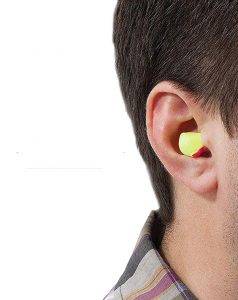
Although noise is everywhere, human ears can only take so much of the loud sound. Normal noise levels considered easily bearable can go up to 75 decibels and anything going above 85 decibels or higher puts human hearing at the risk of irreversible hearing loss.
As a point of reference, just consider this: faint whispers are around 30 decibels while conversations can go up to 60 decibels. On the other hand, noise in a busy cafe or restaurant may reach around 70 decibels. Noise in all these situations remains below the limit and doesn’t really demand any ear protection.
But as the decibels get higher such as when using a blender, hairdryer or vacuum cleaner, the noise levels can go up to 85 decibels. Luckily, blenders, hairdryers, and vacuum cleaners at home are only used for so long, so no worries there either. Other machines like handheld drills are louder and using these for even shorter periods of time warrants the use of some kind of ear protection.
That said, being exposed to a loud sound temporarily doesn’t mean hearing damage unless the noise goes beyond 120 decibels. So if a motorcycle speeds by, which would be around 90 decibels or so, which won’t cause much of a risk. However, if a gun were fired near you without any ear protection, then you’d be exposed to around 140 decibels which could cause temporary issues with hearing.
So, as you can see, earplugs can come in handy in various everyday situations as well. The most popular ones, of course, remain the following:
- Sleeping with a snoring partner, in a busy dorm room, living close to the main road or other night-time noises.
- Loud workplaces such as a construction site, operating machinery, mining, and airport ground staff to name just a few.
- Traveling by air to seek relief from pressure changes, at busy train stations or during a noisy commute.
- Concerts and other musical gatherings can get very loud. People such as DJs, sound technicians, nightclub workers, and rock stars can all benefit from using earplugs to muffle out the noise.
- Swimming is also another circumstance where people like to use earplugs, but foam ones are not recommended. Instead, swimmers opt for plastic or silicone versions.
Types of Earplugs
- Foam is not the only material used for making earplugs, although it is definitely the most cost-effective one. Other options include wax, silicone, and custom-made varieties, each with its own set of benefits.
- Wax earplugs, for instance, provide excellent protection against noise or water entry. They can also work equally well for sleep, study, travel or noisy workplaces. Wax is soft and reusable when cleaned thoroughly. People who may be allergic to foam can use wax earplugs instead.
- Soft silicone earplugs are preferred by many users as these tend to contour comfortably to any ear shape. These are also reusable earplugs and make for a fairly decent comfortable fit for long periods of time. Soft silicone is suitable for swimming, sleeping, traveling and working with loud machinery. Although for very loud workplaces, people may wish to add on additional protection by wearing earmuffs on top of the earplugs.
- Custom-made earplugs are made by taking an ear impression or ‘cast’ of the outer ear and inner canal to determine the exact individual ear size and shape. Custom-made varieties of earplugs can be tailored individually to musicians, swimmers, shooting and hunting aficionados and also for sleeping purposes.
Earplugs Vs Other Noise Cancellation Devices
Noise cancellation, by itself, is a process that helps to somewhat, or completely reduce noise levels. Because not all noise is created equal, there are also different types of noise cancellation devices to deal with the clamor. With earplugs remaining the most basic kind, other noise cancellation devices include the following options:
Earbuds are often used synonymously with earphones but are not the same thing. Whereas earbuds do not get inserted into the ear canal, but rest outside the ears, earphones are inserted into the ear canal. Understandably, this doesn’t make earbuds the best option for noise cancellation.
Although some are cushioned, many others are not. With this one-size-fits-all option, earbuds can be uncomfortable to wear especially if they don’t fit securely to the ridges of the ears. What they do is allow in ambient noise to let you hear what’s going on around you. This way, they don’t seal out all noise but do provide a small measure of safety when using them for running or walking outdoors.
Earphones, also known as in-ear headphones come cushioned for a comfortable fit inside the ear canal. Cushioning materials can include rubber, foam or silicone. Those with noise-canceling features not only block out sound by providing a physical barrier but also come with active noise cancellation (ANC) features. Because they go inside the ear, earphones are usually available in different sizes. Both wired and non-wired varieties are available for earbuds and earphones.
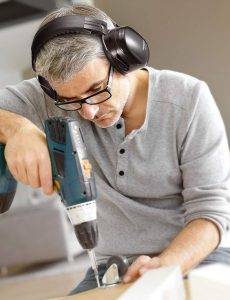
Also, earmuffs remain akin to earplugs with both providing passive noise reduction and the two are often recommended to be worn together in high-noise level industries.
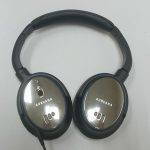
Now that we’ve got you covered with the many noise reduction and noise cancellation options available, it’s time to get back to our topic of the day, the Laser Lite® earplugs by Howard Leight.
Company
Howard Leight operates under the Honeywell banner, a giant in offering smart home solutions, automation control, and safe and efficient solutions for industries and manufacturing. The Howard Leight brand specializes in providing leading electronic and passive ear protection for the workplace, range, tactical, hunting, and sporting scenarios.
Their protective solutions cover a broad range of services such as amplifying surrounding sounds voices, machines and warning signals to safe levels yet providing good hearing protection. Their protective gear effectively blocks loud impulse sounds, limiting these to safe levels. You can get both high-profile and low-profile protective gear that is ideal for sports and other applications.
Howard Leight caters to everything from loud industrial and musical environments to everyday operations such as yard work, using power tools, travel, and study.
Features and Specs
Although the Laser Lite® foam earplugs are a basic product from this supplier of personal protective equipment, it comes with many features that put it above the other competitors in the market.
— Material
Laser Lite® by Howard Leight uses low-pressure polyurethane foam for its construction. This light-weight material is suitable for all-day comfort and comes with an open-cell structure responsive to body heat. It also has all the properties of contouring to the shape of the ear canal over time. The self-adjusting foam can work well with every user. Plus, the smooth, soil-resistant, cell foam skin prevents dirt buildup on the earplug’s surface.
— Appearance
Laser Lite® foam earplugs are available in a dual-colored bright yellow and magenta combination for easy and clear visibility. This high visibility feature makes these earplugs perfectly suited for facilities with compliance checks and those with low tolerance for packaging waste.
— Shape
Laser Lite® foam earplugs feature a contoured T-shape for convenient insertion, wear and removal.
— Size
These are one-size-fits-all earplugs.
— NRR
Laser Lite® has a noise reduction rating of 32 decibels.
— Packaging
These earplugs are available in paper bag packaging with every pair wrapped individually.
— Two varieties
The Laser Lite® earplugs are available in both corded and uncorded varieties. The corded varieties use cotton cords for process industries such as pulp and paper.
How to Wear Laser Lite® Earplugs?
Even though foam earplugs are among the most forgiving products when it comes to insertion, correct fitting is still important for optimal results. To get the right experience out of your earplugs, it is important to use them properly.
Here is a step by step guide to inserting your Laser Lite® earplugs the right way.
The Roll Down
- Make sure your hands are clean prior to handling the earplugs.
- Start by rolling the plug into a thin but crease-free cylinder.
- Ensure that you are rolling and not twisting the earplug into a cylinder.
- Use your fingertips above and thumb below the plug to compress.
- Compress cylinder as tightly as possible. This won’t affect the earplug as it’s made to handle pressure this way.
- Once rolled and compressed correctly, insert your Laser Lite® earplug into your ear.
Inserting the Earplug
- Earplug insertion becomes easier when the ear canal is straightened and enlarged by pulling the outer ear upwards.
- To do this, hold the top of your right ear with your left hand by reaching over the head with your left hand.
- Holding the plug in your right hand gently insert the plug in directly.
- Hold in place with one fingertip until the earplug expands and blocks out the noise.
- Repeat on the other side.
Note: It’s important that earplugs be inserted in the right and left ears using the right and left hands respectively. Using the hand on the same side as the ear gives the ear plug the best line of approach for optimal fitting.
Importance of Correct Insertion
- It’s important to insert the earplug when compressed so that its diameter is less than that of the ear canal. This makes it easier to easily slide it into place.
- Holding the earplug in place after insertion ensures that it doesn’t dislodge or slip out before expanding enough to secure itself in place.
- Once the plug has started expanding, pushing or twisting it won’t enhance its fit. If it doesn’t feel right, remove, reroll and try again.
- Initially using foam earplugs, or any other kind, may seem somewhat uncomfortable. For foam earplugs, in particular, the sensation arises because foam expands within the ear. The uncompressed earplug is longer than its rolled down version and upon expansion will touch parts of the ear canal which may seem slightly odd.
Assessing the Fit
This can be done in three simple ways. First is a visual inspection where most of the plug should be well inserted in the ear canal with only its end showing. But if half or most of the plug remains visible outside the ear, the fit isn’t done right. However, since foam earplugs can vary in length, this isn’t a very accurate measure to go by.
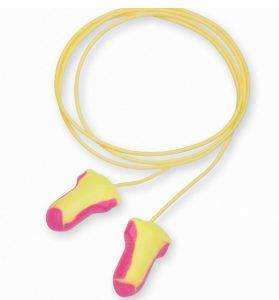
The final assessment has to do with the plug’s noise-reducing function. Press firmly cupped hands over the ears while listening to a steady sound. With correctly fitted plugs, the noise level should be about the same.
| Pros | Cons |
|
|
User Comments
Laser Lite® foam earplugs boast an impressive, positive rating among its users. While it’s hard to please everyone, users, in general, have found this pair of earplugs to be comfortable in different situations and for fairly long periods of time.
Most users are pleased with the noise reduction effect of these earplugs. They say that the plugs don’t silence out all sound, which works well for them to hear the important stuff. But the decibel reduction is sufficient to help with a good night’s sleep.
The one-size-fits-all seems to be an issue for some users with small ears find these earplugs to be too big for a comfortable fit.
Regarding usability, manufacturers rate these to be disposable given their foam construction. Users, on the other hand, have a mixed response. Some, who have used them repeatedly are happy with the few subsequent uses, for, after all, these are foam earplugs and can’t be used forever. Others have preferred using them only once and given their reasonable price tag, don’t mind getting a new pair for every use.
The fact that these are available in multi-packs with packs going up to 100 pairs per pack, users who swear by Laser Lite® don’t mind getting these larger packs for their daily use.
Conclusion
Overall, the Laser Lite® foam earplugs have the nod of approval from most users. People like this pair given its comfortable construction and easy usability. Those working in certain industries depend on their protective hearing and high visibility when on the job. It just goes to show that even the simplest of foam earplugs can’t go wrong when you get it from a leading brand in the ear protection industry.
